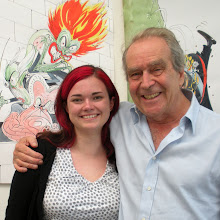In general, your dummy doesn’t need to be completely composed of finished illustrations. You can do finished sketches of what the finals will look like, and include a couple of finished spreads so the publisher has an idea of how the rest of the book will look, as well as your approach to style. I’ve been including fully finished pieces in my dummies since the work is already done, and why not show that to a publisher when it has the potential to impress? However, if you’ve just got an idea going for a book, don’t feel like you have to go through and complete everything before sending it out. There’s a huge possibility that, if an editor decides to publish your book, he or she may want you to change some of the illustrations, resulting in a lot of extra work if you’ve completed everything already.
When I began sending out dummy books I was getting everything printed at Kinkos as double sided color copies on 11” x 17” paper, then cutting the excess paper off and stapling the copies together in book form. This was all fine and dandy, but rather expensive (about $30 per book, and that was because the employees usually forgot to charge me for a double sided copy rather than a single sided one). If you get the dummies sent back from the publisher, it’s fine, but since I’ve been sending most of my work to the UK I haven’t been getting it back (self addressed stamped envelopes don’t work for international mail, unfortunately). So I finally wised up and took the advice of the Amazing Ms. Jade Nellans who had used Lulu.com to produce dummy books for publishers. They’re much cheaper, plus they don’t look “too” published. The only downside has been that Lulu doesn’t support my book size, nor does it have something proportional (my book is 8” x 6”), so I set it up in its original size on 9”x 7” paper and cut off the excess. If you end up needing to cut off extra space it can be done without having to remove the staples---I have done it both with a Xacto knife and a pair of scissors. If you’re good with scissors I would suggest using those as it’s a bit easier to manage. When I attempted the Xacto I ended up cutting my finger (not badly), which was a first for me. I managed 3 years of art school with no Xacto based incidents only to be done in by a dummy book.
Dummy books: the original print from Lulu (with extra space) on the left, and the cropped version on the right.
Full spread of the Lulu dummy--the print quality is excellent.
Setting up your dummy for Lulu can be a bit tricky if you’ve never done it before, so I’ll attempt to go through the process. The good news is that once it’s done correctly and you upload it, you never have to redo it! My friends that have used Lulu have all put their books together using InDesign, but since I’m a bit InDesign illiterate, I set each spread up in Photoshop, then saved it as PDF and combined all the files together in Acrobat to make one LARGE PDF document. There are two things to keep in mind when making your PDF: 1) you don’t need to include your cover art as Lulu has that set up separate, and 2) you have to include a single blank page at the beginning and end of the document (before and after the endpapers), otherwise the printing will be out of sequence. I made the mistake of not doing this the first time I got my dummy printed and all of the spreads were off. I changed the PDF file, reuploaded, reordered, and everything was peachy keen. And speaking of uploading, my file was so big I had to use an FTP client (I used FileZilla, which you can get here if you don't already have an FTP client) to get it on Lulu’s page, so be prepared to do the same.
Setup in Acrobat. I set everything as single page spreads because I was paranoid about how it would print if I did everything as double page spreads...better safe than sorry. The color mode is in CMYK for printing.
Now, I know what you’re thinking…with all this extra work, what’s the price for the new books? Are you really saving money? Well, my friends, yes I am. Through Lulu the books only cost about $10 each. Shipping has been around $14 when I have ordered 4 books. Even with that, they still cost less than what I was paying at Kinkos, and the quality has been much nicer. Turnaround is great, too; the last order took about a week to receive, and that’s including printing and shipping. Not too shabby, if you ask me…
Well, there you have it: my entire book process. I hope that someone has found it useful, and moreover, I’m hoping that soon all of this work will pay off.





I certainly found this useful. I believe I will have found it more useful when you post that your book has been published and sold more copies than The Cat in the Hat.
ReplyDeleteThat would be amazing. Mostly because it means I could quit my day job...and move to England.
ReplyDelete